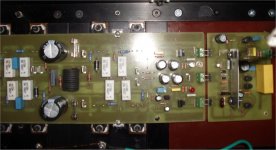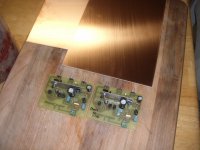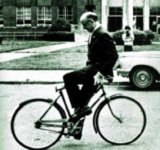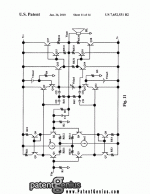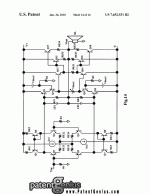For TMC Ci must be smaller than Co and for TPC Ci must be larger than Co....
There is no 'must' about it. Using Ci>Co for TPC only ensures that the current drawn from the second stage is reduced. This is a good idea if your second stage cant provide the current in the first place. I mentioned this somewhere in this thread nearly four years ago.
For TMC just why, from first principals please, do you think Ci<Co? I fail to appreciate this constraint.
Last edited:
The objective is the keep all key parameters as much as possible the same: unity loop gain frequency (ULGF) .....
Making the component values the same for TMC and TPC ensures that the FOWARD path unity gain frequencies are the same, (as you must have found out by now at long last!) and not neccesarily the unity loopgain frequency.
Last edited:
Making the component values the same for TMC and TPC ensures that the FOWARD path unity gain frequencies are the same, (as you must have found out by now at long last!) and not neccesarily the unity loopgain frequency.
Hi Mike,
I also think there is no "must" about it, but TPC and TMC do not each necessarily prefer the same relationship between the capacitors. Moreover, there is no must that the capacitors be the same in both approaches for a fair comparison, or to achieve comparable total loop gain around the output stage.
In my design, TMC liked C2 > C1 by a fair amount, while TPC was happy with C1 = C2. I was able to adjust both designs to have about the same amount of distortion reduction, and when I checked the total loop gain around the output stage, both were about the same in terms of gain crossover frequency and phase margin.
I discussed those results about a week ago on my book thread. In the same context, I also noted that clipping behavior for TPC seemed worse than that for TMC, but both were worse than CMC (but of course CMC had higher distortion).
Cheers,
Bob
Member
Joined 2009
Paid Member
It would be more interesting (and maybe a 1st for some of the "just listen" crowd) if two complete "Blueprinted" amps with fr, noise, output Z matched to give <0.1 dB response difference into the real world loudspeaker loads were compared with a good blinding protocol
once you've debugged the listening setup then change the compensation in one amp and let us know your listening result
when Stereophile tried it with "high end" tube vs tweaked for null difference "mid price" SS amplifiers in the Carver Challenge the "Golden Eared" reviewers possibly most responsible for currrent audiophile mythology couldn't tell the difference
we might guess the starting tube vs SS amp difference could have been bigger than the expected "fair" TPM/TMC compensation of identical amps
once you've debugged the listening setup then change the compensation in one amp and let us know your listening result
when Stereophile tried it with "high end" tube vs tweaked for null difference "mid price" SS amplifiers in the Carver Challenge the "Golden Eared" reviewers possibly most responsible for currrent audiophile mythology couldn't tell the difference
we might guess the starting tube vs SS amp difference could have been bigger than the expected "fair" TPM/TMC compensation of identical amps
Last edited:
It would be more interesting (and maybe a 1st for some of the "just listen" crowd) if two complete "Blueprinted" amps with fr, noise, output Z matched to give <0.1 dB response difference into the real world loudspeaker loads were compared with a good blinding protocol
once you've debugged the listening setup then change the compensation in one amp and let us know your listening result
when Stereophile tried it with "high end" tube vs tweaked for null difference "mid price" SS amplifiers in the Carver Challenge the "Golden Eared" reviewers possibly most responsible for currrent audiophile mythology couldn't tell the difference
we might guess the starting tube vs SS amp difference could have been bigger than the expected "fair" TPM/TMC compensation of identical amps
Short of somebody building 2 complete amps just to do this comparison, I have just the setup (below 1) . I also have some expendable FR-4 , new scope probes and a -107db source (my soundcard). On 2/5, I can whip up another batch of AX's (Bob's textbook example amp) with universal TPC/TMC capability. I don't have enough KSA/KSC's (1845/992 1381/3503's) now.
I can make the boards now (pix 2) .. I got the FR-4 free.
OS
Attachments
when Stereophile tried it with "high end" tube vs tweaked for null difference "mid price" SS amplifiers in the Carver Challenge the "Golden Eared" reviewers possibly most responsible for currrent audiophile mythology couldn't tell the difference
I think Bob just wore them down.
we might guess the starting tube vs SS amp difference could have been bigger than the expected "fair" TPM/TMC compensation of identical amps
Come now, you can`t hear the difference between compensation methods?
I read on the Internet (here actually) that there is truly a night and day different and easily discerned - one just has to listen.
Come now, you can`t hear the difference between compensation methods?
I read on the Internet (here actually) that there is truly a night and day different and easily discerned - one just has to listen.

In this case , I absolutely agree. But CMC ... say from 47pF to 150pF , you would hear (amount of compensation). To be a wisearse , you would also hear 10-15p .. as your tweeters were a fryin'
OS
Member
Joined 2009
Paid Member
I read on the Internet (here actually)

you get 10 out of 10 for that one !
As far as I can tell, the US patent office will grant anything. I understand that the invention is not required to to be useful or to actually work, but apparently they don't even bother to check that the idea is new and not easily derived from prior art.Please have a look at: US Patent 7652531
Those pirates have stolen my baby!
On a lighter note, have a look at some of the "preferred embodiments" in this patent.
Figure 11 is just TMC applied to that Slone topology with the undefined bias.
In figure 14 they're not even giving the poor thing a fair chance. Burn baby, burn!
Attachments
Last edited:
To all,
Please have a look at: US Patent 7652531
Those pirates have stolen my baby!
@ raven1985, thx for the info.
Cheers,
E.
At least he correctly calls the second stage a transimpedence stage (TIS) instead of a "VAS".
Last edited:
Hi Mike,
I also think there is no "must" about it, but TPC and TMC do not each necessarily prefer the same relationship between the capacitors.
I reckon any ratio of capacitors can be made to work optimally well in both cases. I do not subscribe to the view that there is an "optimal ratio" of capacitors for TPC or TMC.
To all,
Please have a look at: US Patent 7652531
Those pirates have stolen my baby!
@ raven1985, thx for the info.
Cheers,
E.
Your baby? Are you sure?
Moreover, there is no must that the capacitors be the same in both approaches for a fair comparison, or to achieve comparable total loop gain around the output stage.
They have to be the same for identical forward path unity gain frequency, which is the primary prerequisite for an apples and apples comparison.
- Home
- Amplifiers
- Solid State
- Bob Cordell Interview: Negative Feedback
